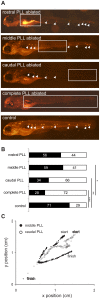Zebrafish larvae exhibit rheotaxis and can escape a continuous suction source using their lateral line
- PMID: 22570735
- PMCID: PMC3343021
- DOI: 10.1371/journal.pone.0036661
Zebrafish larvae exhibit rheotaxis and can escape a continuous suction source using their lateral line
Abstract
Zebrafish larvae show a robust behavior called rheotaxis, whereby they use their lateral line system to orient upstream in the presence of a steady current. At 5 days post fertilization, rheotactic larvae can detect and initiate a swimming burst away from a continuous point-source of suction. Burst distance and velocity increase when fish initiate bursts closer to the suction source where flow velocity is higher. We suggest that either the magnitude of the burst reflects the initial flow stimulus, or fish may continually sense flow during the burst to determine where to stop. By removing specific neuromasts of the posterior lateral line along the body, we show how the location and number of flow sensors play a role in detecting a continuous suction source. We show that the burst response critically depends on the presence of neuromasts on the tail. Flow information relayed by neuromasts appears to be involved in the selection of appropriate behavioral responses. We hypothesize that caudally located neuromasts may be preferentially connected to fast swimming spinal motor networks while rostrally located neuromasts are connected to slow swimming motor networks at an early age.
Conflict of interest statement
Figures




References
-
- Dijkgraaf S. The functioning and significance of the lateral-line organs. Biological Reviews of the Cambridge Philosophical Society. 1963;38:51–105. - PubMed
-
- Metcalfe WK, Kimmel CB, Schabtach E. Anatomy of the posterior lateral line system in young larvae of the zebrafish. The Journal of Comparative Neurology. 1985;233:377–389. - PubMed
-
- Nicolson T, Rüsch A, Friedrich RW, Granato M, Ruppersberg JP, et al. Genetic analysis of vertebrate sensory hair cell mechanosensation: the zebrafish circler mutants. Neuron. 1998;20:271–283. - PubMed
-
- Fero K, Yokogawa T, Burgess HA. Kalueff AV, Cachat JM, editors TotowaNJ: Humana Press; 2010. Zebrafish Models in Neurobehavioral Research.
-
- Eaton RC, Didomenico R. Role of the Teleost Escape Response during Development. Transactions of the American Fisheries Society. 1986;115:128–142.
Publication types
MeSH terms
Grants and funding
LinkOut - more resources
Full Text Sources

